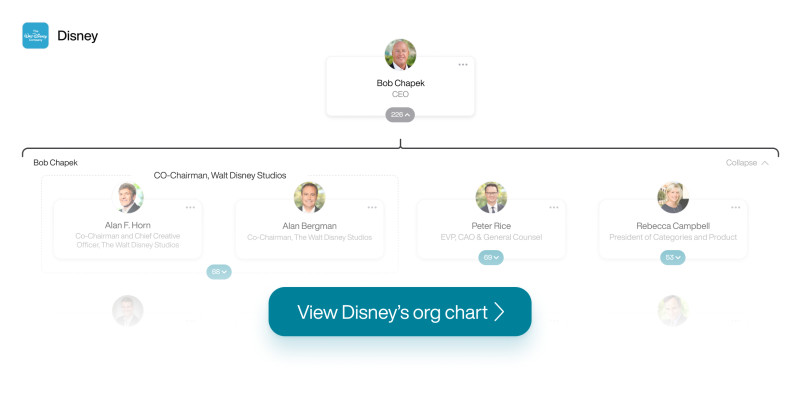The Most Influential People Behind the Scenes at Disney
Table of contents
The Org has identified the most influential people behind the scenes at The Walt Disney Company, one of the world’s longest standing and leading names in the entertainment and media industries. Here’s our exclusive org chart of the top executives and their roles.

The Org has identified the most influential people behind the scenes at The Walt Disney Company, one of the world’s longest standing and leading names in the entertainment and media industries. Here’s our exclusive org chart of the top executives and their roles.
In February, longstanding Disney CEO Bob Iger unexpectedly resigned after 14 years at the helm, and another Bob--former head of Disney’s lucrative parks, experiences and products unit Bob Chapek--was given the keys to the Magic Kingdom. Although Iger is departing as CEO, he will stay on as executive chairman until 2021, overseeing Disney’s creative endeavors.
With Chapek leaving his position to take up the CEO role, and the recent surprise resignation of Kevin Mayer, who led the company’s direct-to-consumer and international business arm, Disney’s executive leadership has had a recent reshuffle.
Disney's history
Headquartered at the Walt Disney Studios in Burbank, California, Disney is the world's second-largest media conglomerate in terms of revenue, after Comcast. Founded in 1923 as a cartoon studio by brothers Walt and Roy Disney, its films have often echoed a vision of America’s collective ideals with working class heroes like Mickey Mouse.
In 1940 Disney went public, and kept growing through the mid-20th Century with Disneyland opening in 1955. In 1966 Walt Disney died, but his vision continued to flourish into the 21st century. Today, Disney is a global powerhouse with business segments covering media networks; parks, experiences and products; studio entertainment; and direct-to-consumer and international, and the company is worth an estimated $130 billion.
A recent history of Disney leadership
Bob Iger was named COO of Disney in 2000, and became CEO in 2005. He is only the sixth CEO of the company, following Michael Eisner who was ousted after a shareholder coup. Iger led Disney into the streaming age, with the launch of Disney+ (and birth of Baby Yoda), and through an acquisition spree that gave it one of the deepest family-friendly content libraries of any media company, and $13 billion revenue in 2019.
Chapek has been eyed as Iger’s successor for some time. He joined Disney in 1993, where his focus was on finding new and profitable ways of distributing and managing the company’s huge library of intellectual property. Since then he has overseen many key parts of the company, and was most recently head of parks, experiences and products, which made Disney $7 billion last year, nearly half of its operating profits.
In his first move as CEO Chapek announced a new leadership team for parks, experiences and products, chaired by Josh D’Amaro, who has been with Disney since 1998 and most recently served as president of Walt Disney World Resort.
He has also tapped former Disneyland Resort president Rebecca Campbell to replace Kevin Mayer. Mayer left Disney last week to become the CEO of popular short-form video app, TikTok. His departure was unsurprising to some, who saw him as being snubbed for the CEO role after his success overseeing the launch of Disney+ last year, which now has more than 50 million subscribers.
Chapek said he could think of no one better to lead Disney’s effort to grow its direct-to-consumer business and continue to expand into new markets than Campbell, who served as Disney’s president of the Europe, Middle East, and Africa region and played a critical role in the launch of Disney+.
A number of longstanding members of the executive team have stayed put, including The Walt Disney Company senior executive vice president, general counsel and secretary Alan Braverman, who has been with the company since 1996, when Disney acquired ABC. Alongside Braverman are two other Alans; Alan Bergman and Alan Horm, who co-chair The Walt Disney Studios, overseeing Disney’s studio entertainment division. Horn is also COO of The Walt Disney Studios, responsible for the overarching creative strategy.
Disney is not a brand unmarred by controversies, and it has drawn significant criticism for “Disneyfication” of the country’s history in its parks, media content, and merchandise, yet, the company continues to prove popular with consumers.
But COVID-19 has taken a toll on Disney, forcing it to close its parks and cruise line businesses and furlough around 100,000 workers. Iger has taken back some day-to-day control and has agreed to forgo his salary, and Chapek has agreed to his being halved.
It's not all bad news, with Disney’s streaming services Disney+, Hulu+ and ESPN+, all expected to have increased engagement. The company’s second quarter earnings, the first with Chapek as CEO, came out this month, and showed mixed results with $18.01 billion in revenue and 60 cents earnings per share. Parks, experiences and products were hit hardest with a 58 percent drop in operating income, compared to the same period last year.
Chapek said the parks would start to reopen with phased approaches and new protocols and procedures would be installed to maintain guest and employee safety. The company is presenting its reopening plan to an Orange County task force this week.
As Walt Disney said; Disneyland would never be completed as long as there was imagination left in the world.
--
Sign up now: Stay up to date, level up and hire better with our behind the scenes newsletters at the world’s top startups.


The ORG helps
you hire great
candidates
Free to use – try today
